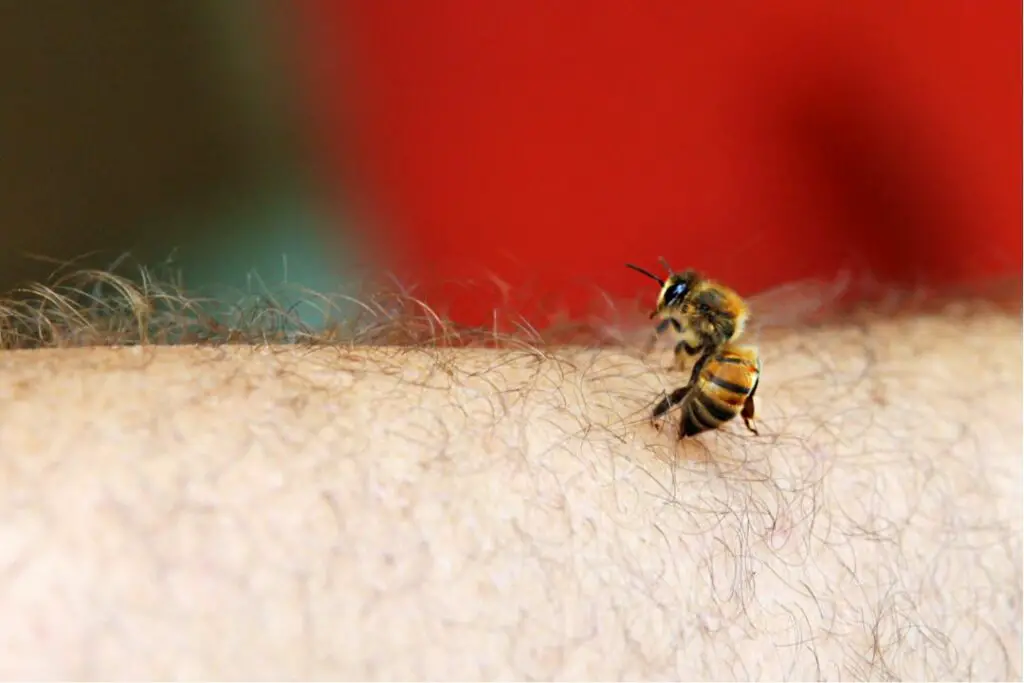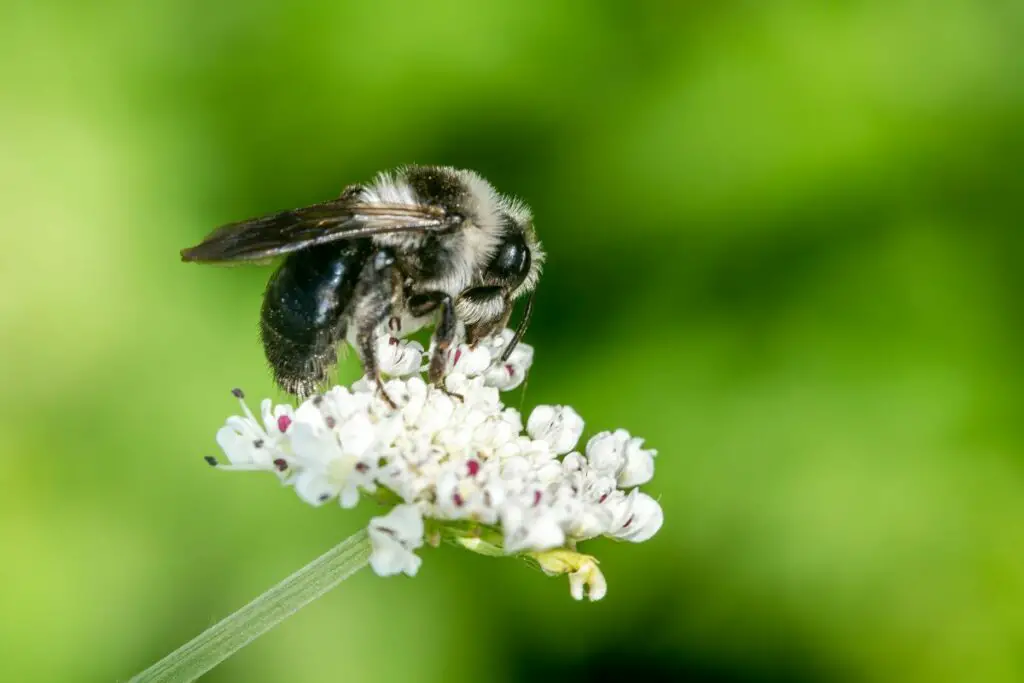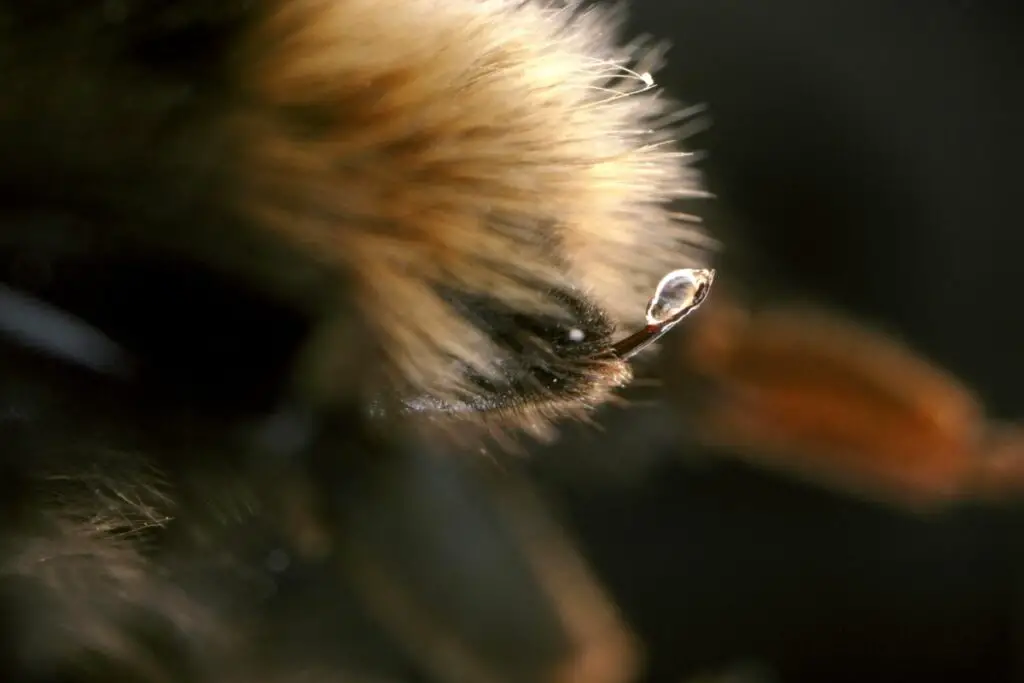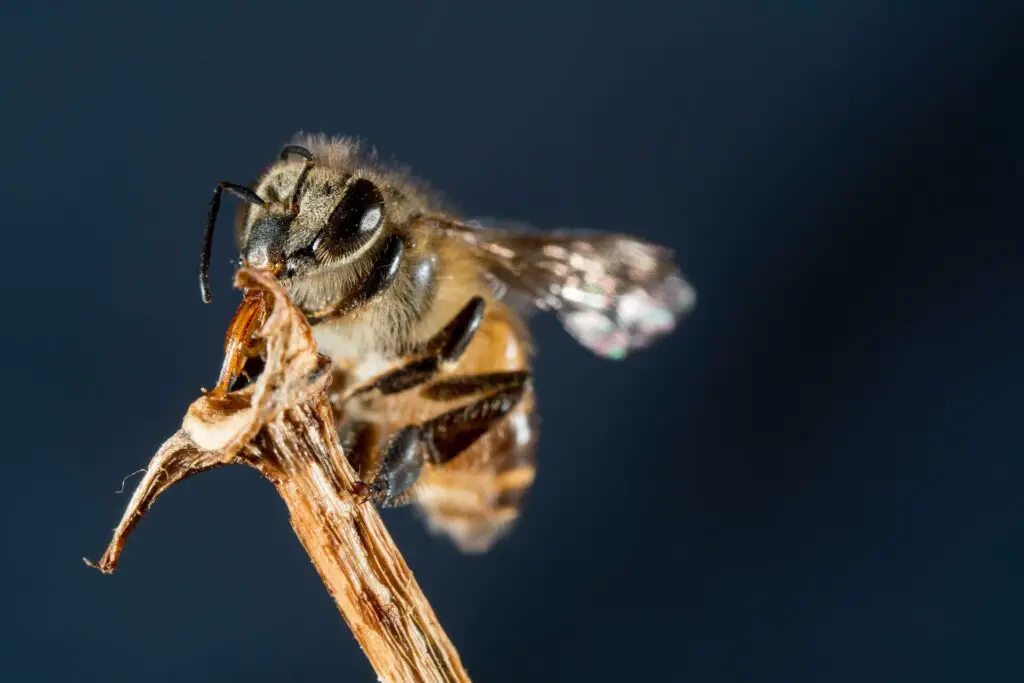Last updated on January 19th, 2024 at 04:12 pm
No, only female bees can sting, and even among female bees, only bees from the honey bee, bumble bee and solitary bee families sting when threatened.
Which bees sting? – Honeybee, Bumblebee, Africanized Honeybee, Carpenter Bee, Sweat Bee, Mason Bee
Which bees don’t sting? – Male bees of any species (Drones), Stingless bees (e.g., Meliponini tribe)
So, with the short answer out the way, let’s take a closer look at the stinging habits of bees and why some bees sting.
Why Do Only Female Bees Sting?
Female bees have a stinger, which is primarily used for protection.
Female worker bees massively outnumber male bees, so it makes sense that they would be equipped with the bees’ main line of defence.
The stinger of a female honey bee has barbs that are embedded in the victim’s skin when it stings, causing the bee to die.
The sting also releases venom with pheromones, alerting other female worker bees to potential threats.
When a hive or nest is threatened, the workers will exit in mass numbers to form a swarm of bees to drive the attackers away.
While one sting may not deter a larger predator, the venom toxicity of hundreds of repeated stings can quickly become unbearable for most animals.
*Interesting fact – In severe cases, when people or animals are attacked by a large swarm, it can lead to fatal bee stings, particularly if affects the airway.
Do Male Bees Have Stingers?
Male bees, regardless of the species, do not possess a stinger and, therefore, cannot sting.
Unlike females, males lack the anatomical structure necessary for stinging.
Although stinging is a common defence mechanism for bees, male bees contribute to their partnerships or colonies in different ways.
For instance, male carpenter bees behave aggressively and dive at predators to deter them.
Does The Honey Bee Sting?

A female honey bee can use its stinger at the end of its abdomen to defend itself from anything it sees as a threat (including you if you’re unlucky).
These hard workers are just as effective at defending their hive as they are collecting pollen.
It does this by thrusting its stinger into the unfortunate victim, be it an animal, insect or, in some cases, a human.
The stinger has a venom sac attached to it, which the bee uses to inject venom into its target through the stinger.
Interesting fact – When a honey bee stings, the barbs on its stinger get stuck in the skin, causing the stinger to remain lodged in its target. This differs from other bees and wasps that can sting multiple times without consequence.
A honey bee’s sting often leads to its demise because the stinger is attached to its internal organs.
As the bee pulls away, it leaves the stinger and part of its abdomen behind, causing fatal injuries.
Therefore, it’s essential to remain calm around honey bees and avoid swatting or provoking them to minimize the chances of being stung.
Do Solitary Bees Sting?

Yes, some solitary bees do have the ability to sting, but they are not aggressive and are unlikely to sting humans unless they are directly threatened or mishandled.
Solitary bees are focused more on pollination than defence, so their stinging behaviour is relatively uncommon.
As with all bees, it’s important to approach solitary bees with caution and respect, but there’s usually no need to be overly concerned about getting stung by them.
Do Bumble Bee Species Sting?

Yes, bumblebees, like other bees, possess a stinger that they can use for defence.
Bumblebees are generally more mellow when it comes to stinging than other bee species.
They are known for their docile nature and often go about their business without showing aggression towards humans.
Interestingly, a bumblebee stinger lacks barbs, just like wasp stings.
This means when a bumblebee stings, its stinger remains intact, allowing it to sting multiple times.
Much like the honeybee, the bumblebee’s sting releases venom that contains specific pheromones.
These pheromones serve as a warning signal to other bees, alerting them to potential danger or a predator’s presence.
This chemical communication helps mobilize other members of the bumblebee colony to join in the defence or take necessary precautions.
Despite their ability to sting, bumblebees generally prefer peaceful interactions with humans.
They play a crucial role as pollinators, aiding in the reproduction of numerous plant species.
Do Mason Bees Sting?
Yes, it’s a common misconception that mason bees don’t or can’t sting.
Now it is true that mason bee sting is much less common than honeybee or wasp stings, but it still happens.
In terms of pain, it’s much less severe than either of the above, with many victims describing it as no more than a small pinch.
Do Stingless Bees Sting?
Stingless bees, stingless honey bees or simply meliponines can’t sting, but that doesn’t mean they aren’t equipped with one.
The sting within these species of bees is underdeveloped to the point that it’s not actually long enough to sting the target.
Despite not having the ability to inject bee venom, they still use their powerful mandibles to drive off any unwanted visitors.
Do Sweat Bees Sting?
These small bees spend most of their day foraging for pollen and nectar, but on a hot summer day, they will happily drink the sweat of animals or humans for sustenance.
Stinging incidents are rare when it comes to sweat bees, but they can happen.
Thankfully their small size means much like the mason bee they won’t cause too much in the way of discomfort.
Do Cuckoo Bees Sting?
A cuckoo bee, also known as a kleptoparasitic bee, belongs to the subfamily Nomadinae, a group of bees that do not build their own nests or collect pollen and nectar.
Instead, they rely on other bee species for their survival.
They exhibit traits such as enhanced armour, larger and stronger mandibles, a hardened abdomen, and a more formidable sting.
Cuckoo bees are “nest parasites.” They invade the nests of other bee species and lay their eggs there.
Once inside the host nest, the female cuckoo bee kills the queen and removes or destroys the host bee’s eggs or larvae before replacing them with her own.
The host bees unknowingly raise the cuckoo bee larvae, feeding and caring for them as if they were their offspring.
Cuckoo bees have evolved certain adaptations to aid in their parasitic lifestyle.
They need robust tools to protect themselves while infiltrating the host nest and eliminating the resident queen and that includes a stinger.
But cuckoo bees are far more concerned with parasitizing nests and rarely interact with humans so we don’t know of any stings.
Conclusion
So, to answer the common question, do all bees sting? Only female bees sting, and it’s only a last form of defence.
If you’ve enjoyed this read, the good news is we’ve got hundreds of other fascinating deep dives into the world of insects below.




